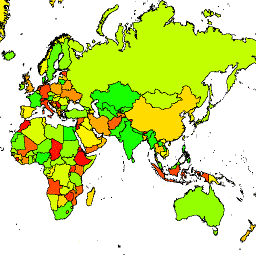
- データセットの可用性
- 2017-12-29T00:00:00Z–2017-12-29T00:00:00Z
- データセット プロバイダ
- 米国国務省地理情報局
- タグ
説明
米国地理情報局は、大規模な国際境界(LSIB)データセットを提供しています。これは、LSIB ライン ベクトル ファイルと、米国国家地球空間情報局(NGA)の World Vector Shorelines(WVS)という 2 つのデータセットから派生したものです。内部境界は、境界、境界紛争、主権に関する米国政府の政策を反映しています。外側の境界は WVS から取得されますが、WVS の海岸線データは古く、一般的に数百メートルから 1 キロメートル以上ずれています。各フィーチャーは、内側の境界と外側の海岸線(該当する場合)で囲まれたポリゴンの領域です。多くの国は、複数のフィーチャーで構成されています(切断されたリージョンごとに 1 つ)。180,741 個の各フィーチャーは、このデータセットで説明されている 284 か国のいずれかのジオメトリの一部です。
テーブル スキーマ
テーブル スキーマ
| 名前 | 型 | 説明 |
|---|---|---|
| OBJECTID | STRING | オブジェクト ID |
| COUNTRY_NA | STRING | 米国で認められている国名 |
利用規約
利用規約
この米国のパブリック ドメイン データには使用制限はありません。
Earth Engine で探索する
コードエディタ(JavaScript)
var dataset = ee.FeatureCollection('USDOS/LSIB/2017'); var styleParams = { fillColor: 'b5ffb4', color: '00909F', width: 3, }; var countries = dataset.style(styleParams); Map.setCenter(16.35, 48.83, 4); Map.addLayer(countries, {}, 'USDOS/LSIB/2017', true, 0.8);
FeatureView として可視化する
FeatureView は、FeatureCollection の高速表示専用の表現です。詳細については、
FeatureView ドキュメントをご覧ください。
コードエディタ(JavaScript)
var fvLayer = ui.Map.FeatureViewLayer('USDOS/LSIB/2017_FeatureView'); var visParams = { color: '00909F', fillColor: 'b5ffb4', width: 3, opacity: 1 }; fvLayer.setVisParams(visParams); fvLayer.setName('USDOS/LSIB/2017'); Map.setCenter(16.35, 48.83, 4); Map.add(fvLayer);
